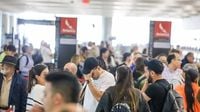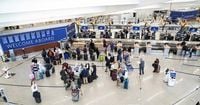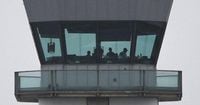Air travelers across the United States faced a perfect storm of delays, cancellations, and mounting frustration this week as the federal government shutdown entered its second week, leaving air traffic control facilities short-staffed and airports scrambling to manage unprecedented disruptions. From coast to coast, the impact was felt by millions, with ripple effects extending even into Canadian airspace.
On October 8, 2025, the Federal Aviation Administration (FAA) reported that six major air traffic control facilities were operating with fewer controllers than required, a direct consequence of the ongoing government shutdown that had stretched into its eighth day. According to CNN, the affected facilities included control towers near Washington, DC, and Denver, as well as those overseeing traffic at Newark Liberty International Airport, Orlando International Airport, and regional air route traffic control centers in Albuquerque and Los Angeles. The shortages were not isolated incidents; rather, they reflected a nationwide pattern of stress and strain on the aviation system.
At Ronald Reagan Washington National Airport, the control tower was short-staffed between 5 p.m. and 10 p.m. local time on October 8, with the FAA warning that flight delays averaging 31 minutes were probable. Denver’s control tower faced similar challenges from 9 p.m. to midnight Eastern Time, while Newark Liberty International Airport experienced staff shortages from 6 p.m. to 9 p.m., resulting in estimated delays of up to 30 minutes. Earlier that same day, Newark’s facility also operated with insufficient staff for two hours starting at 7 a.m., marking the only reported “staffing trigger” for a morning shift, as detailed in the FAA’s operations plan.
Orlando International Airport’s approach control was not spared, running below normal staffing levels from 8 p.m. to 11 p.m. Meanwhile, the Albuquerque Center was short-staffed until 10 p.m. Eastern, and the Los Angeles Center operated with fewer controllers from 7:30 p.m. to 1 a.m. the following morning. The situation was so fluid and unpredictable that Transportation Secretary Sean Duffy told CNN, “There’s no rhyme or reason to what’s happening with these controllers, but the truth is, we need to open up the government again.”
While the FAA has a toolkit of strategies to manage airspace during crises—including rerouting flights and implementing metering programs—sometimes delays are unavoidable. “When you see delays, it’s because we’re not willing to take additional risk if we don’t have the staff to fly your flight on time,” Duffy explained. The numbers were stark: over the previous nine months, only 5% of air travel delays were caused by staffing shortages, but on October 8, that figure soared to 53%, as reported by CNN.
Compounding the crisis, the FAA issued emergency air traffic control alerts nationwide on October 8, according to the Daily Mail. Equipment malfunctions at major hubs—including New York, Los Angeles, Chicago, Denver, Atlanta, and Miami—forced the FAA to slow the flow of air traffic, a process known as metering flights, to prevent congestion and accidents. The alerts, labeled FCAGD1 and FCAGD3, affected nearly all flights up to 60,000 feet, with some delays stretching beyond five hours. FCAGD1 imposed the heaviest restrictions, allowing as few as five to 17 flights per hour, while FCAGD3 permitted seven to 14 flights per hour with average delays of three minutes. Airlines such as Delta, American, and United reported major scheduling disruptions, and the FAA’s Unified Delay Program and Delay Assignment System were deployed to manage the backlog.
Staffing shortages due to the shutdown were at the heart of many of these problems. Controllers, considered essential government employees, were required to work without pay, with their next paycheck scheduled for October 14 only covering hours worked before the shutdown began. The union representing controllers warned that the system’s fragility was being exposed. “Air traffic controllers are going to do everything they can to show up to duty, save people’s lives, and do the job that we do day in and day out,” said National Air Traffic Controllers Association President Nick Daniels in an interview with CNN. “Air traffic controllers don’t start a shutdown and we don’t end a shutdown. Politicians are the ones that start the shutdown, and they’re the only ones that have the ability to end the shutdown.”
The human toll was evident. At Baltimore/Washington International Airport, Maryland Governor Wes Moore publicly thanked workers who continued to show up despite not being paid. “They’re doing it because they’re patriots. They’re doing it because they know that this work matters,” Moore said. Congressman Kweisi Mfume joined the call for an emergency supplemental appropriation to ensure air traffic controllers receive pay, stating, “And yes, they are essential. And yes, we have an obligation to make sure that the skies are safe. People are beginning now to worry about flying, and we should never, as a nation, get to that point.”
On the ground, the chaos was palpable. Nashville International Airport’s approach facility had to shut down for five hours on October 7 due to staffing shortages, causing ground delays that averaged about two hours and affected nearly 40,000 passengers, according to ABC News. Controllers at the airport described the situation as “absolutely insane,” with only four controllers available and the airspace temporarily handed over to a regional center. The frustration was audible in radio transmissions: “We’re low staffed all the time (but) this is very rare. We have four controllers in the building and we went to a (visual flight rules) tower only, at a level 10 airport in the (national air space), which is absolutely insane,” one controller told pilots.
The situation was not unique to Nashville. On October 6, the control tower at Hollywood Burbank Airport in California was forced to shut down for more than two hours when no controllers showed up. Flights had to use a Common Traffic Advisory Frequency—a system more common at small regional airports—so pilots could announce their intentions and positions. Meanwhile, airports in Boston, Dallas, Chicago, and Philadelphia also reported staffing issues, with one-third of flights delayed at Nashville alone, as reported by ABC News.
Despite these challenges, the Transportation Security Administration (TSA) maintained that it had not experienced delays in operations due to officer callouts and remained fully capable of facilitating safe travel for passengers. Yet, the overall picture was grim: according to Cirium, about 92% of over 23,600 flights departing US airports on October 7 took off on time, but that left thousands of travelers stranded or delayed, often for hours.
As the shutdown dragged on, lawmakers from both parties began urging action. Some, like Rep. Kweisi Mfume, called on House Speaker Mike Johnson to reconvene Congress to pass an emergency measure ensuring pay for air traffic controllers until a broader solution could be reached. Meanwhile, Transportation Secretary Duffy, in a post on X, placed blame on “radical Democrats” for the impasse, urging an end to “the madness.”
With no end to the shutdown in sight and the aviation system straining under the pressure, the urgent question remains: how much longer can the skies remain safe and orderly when the people responsible for that safety are working without pay, under mounting stress, and with no clear resolution on the horizon?



